oil level CHEVROLET CORVETTE 2020 Owner's Manual
[x] Cancel search | Manufacturer: CHEVROLET, Model Year: 2020, Model line: CORVETTE, Model: CHEVROLET CORVETTE 2020Pages: 336, PDF Size: 5.21 MB
Page 108 of 336
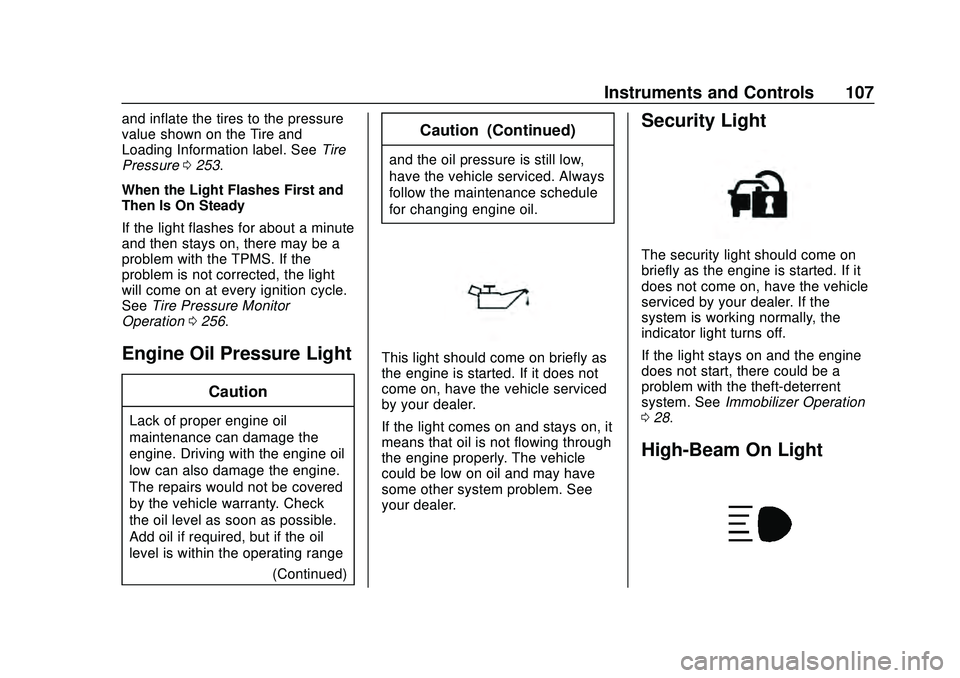
Chevrolet Corvette Owner Manual (GMNA-Localizing-U.S./Canada/Mexico-
12470550) - 2020 - CRC - 4/23/20
Instruments and Controls 107
and inflate the tires to the pressure
value shown on the Tire and
Loading Information label. SeeTire
Pressure 0253.
When the Light Flashes First and
Then Is On Steady
If the light flashes for about a minute
and then stays on, there may be a
problem with the TPMS. If the
problem is not corrected, the light
will come on at every ignition cycle.
See Tire Pressure Monitor
Operation 0256.
Engine Oil Pressure Light
Caution
Lack of proper engine oil
maintenance can damage the
engine. Driving with the engine oil
low can also damage the engine.
The repairs would not be covered
by the vehicle warranty. Check
the oil level as soon as possible.
Add oil if required, but if the oil
level is within the operating range
(Continued)
Caution (Continued)
and the oil pressure is still low,
have the vehicle serviced. Always
follow the maintenance schedule
for changing engine oil.
This light should come on briefly as
the engine is started. If it does not
come on, have the vehicle serviced
by your dealer.
If the light comes on and stays on, it
means that oil is not flowing through
the engine properly. The vehicle
could be low on oil and may have
some other system problem. See
your dealer.
Security Light
The security light should come on
briefly as the engine is started. If it
does not come on, have the vehicle
serviced by your dealer. If the
system is working normally, the
indicator light turns off.
If the light stays on and the engine
does not start, there could be a
problem with the theft-deterrent
system. SeeImmobilizer Operation
0 28.
High-Beam On Light
Page 152 of 336
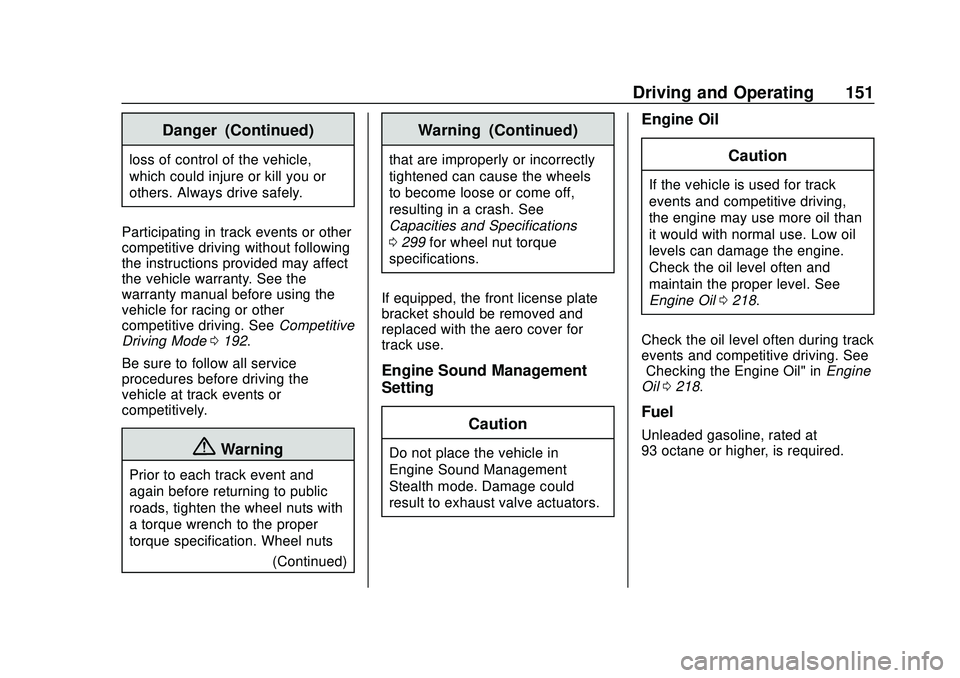
Chevrolet Corvette Owner Manual (GMNA-Localizing-U.S./Canada/Mexico-
12470550) - 2020 - CRC - 4/23/20
Driving and Operating 151
Danger (Continued)
loss of control of the vehicle,
which could injure or kill you or
others. Always drive safely.
Participating in track events or other
competitive driving without following
the instructions provided may affect
the vehicle warranty. See the
warranty manual before using the
vehicle for racing or other
competitive driving. See Competitive
Driving Mode 0192.
Be sure to follow all service
procedures before driving the
vehicle at track events or
competitively.
{Warning
Prior to each track event and
again before returning to public
roads, tighten the wheel nuts with
a torque wrench to the proper
torque specification. Wheel nuts (Continued)
Warning (Continued)
that are improperly or incorrectly
tightened can cause the wheels
to become loose or come off,
resulting in a crash. See
Capacities and Specifications
0299 for wheel nut torque
specifications.
If equipped, the front license plate
bracket should be removed and
replaced with the aero cover for
track use.
Engine Sound Management
Setting Caution
Do not place the vehicle in
Engine Sound Management –
Stealth mode. Damage could
result to exhaust valve actuators.
Engine Oil
Caution
If the vehicle is used for track
events and competitive driving,
the engine may use more oil than
it would with normal use. Low oil
levels can damage the engine.
Check the oil level often and
maintain the proper level. See
Engine Oil0218.
Check the oil level often during track
events and competitive driving. See
“Checking the Engine Oil" in Engine
Oil 0218.
Fuel
Unleaded gasoline, rated at
93 octane or higher, is required.
Page 153 of 336
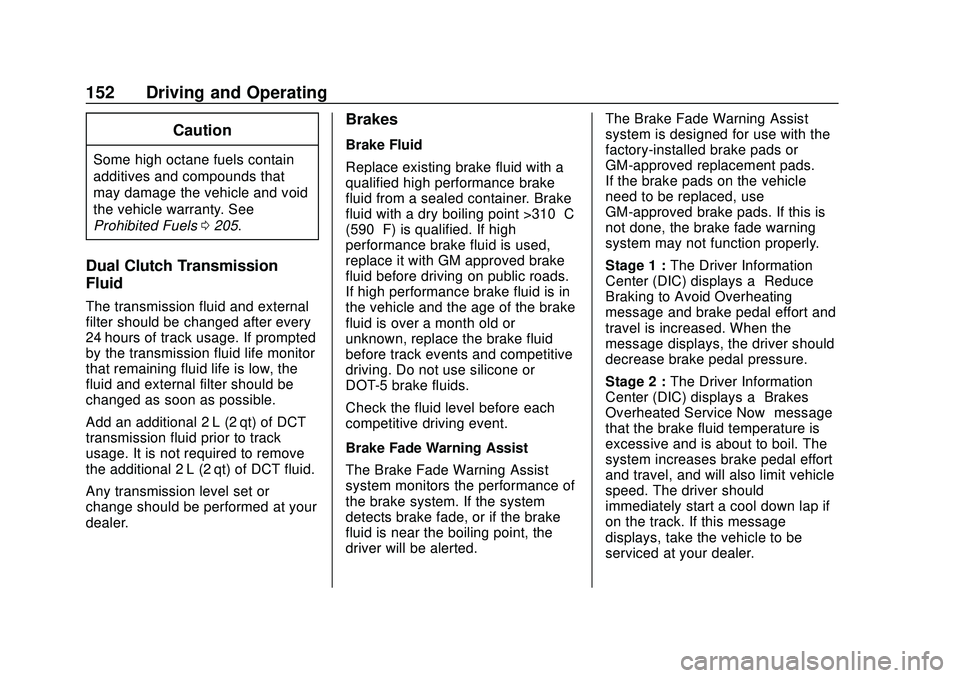
Chevrolet Corvette Owner Manual (GMNA-Localizing-U.S./Canada/Mexico-
12470550) - 2020 - CRC - 4/23/20
152 Driving and Operating
Caution
Some high octane fuels contain
additives and compounds that
may damage the vehicle and void
the vehicle warranty. See
Prohibited Fuels0205.
Dual Clutch Transmission
Fluid
The transmission fluid and external
filter should be changed after every
24 hours of track usage. If prompted
by the transmission fluid life monitor
that remaining fluid life is low, the
fluid and external filter should be
changed as soon as possible.
Add an additional 2 L (2 qt) of DCT
transmission fluid prior to track
usage. It is not required to remove
the additional 2 L (2 qt) of DCT fluid.
Any transmission level set or
change should be performed at your
dealer.
Brakes
Brake Fluid
Replace existing brake fluid with a
qualified high performance brake
fluid from a sealed container. Brake
fluid with a dry boiling point >310 °C
(590 °F) is qualified. If high
performance brake fluid is used,
replace it with GM approved brake
fluid before driving on public roads.
If high performance brake fluid is in
the vehicle and the age of the brake
fluid is over a month old or
unknown, replace the brake fluid
before track events and competitive
driving. Do not use silicone or
DOT-5 brake fluids.
Check the fluid level before each
competitive driving event.
Brake Fade Warning Assist
The Brake Fade Warning Assist
system monitors the performance of
the brake system. If the system
detects brake fade, or if the brake
fluid is near the boiling point, the
driver will be alerted. The Brake Fade Warning Assist
system is designed for use with the
factory-installed brake pads or
GM-approved replacement pads.
If the brake pads on the vehicle
need to be replaced, use
GM-approved brake pads. If this is
not done, the brake fade warning
system may not function properly.
Stage 1 :
The Driver Information
Center (DIC) displays a “Reduce
Braking to Avoid Overheating”
message and brake pedal effort and
travel is increased. When the
message displays, the driver should
decrease brake pedal pressure.
Stage 2 : The Driver Information
Center (DIC) displays a “Brakes
Overheated Service Now” message
that the brake fluid temperature is
excessive and is about to boil. The
system increases brake pedal effort
and travel, and will also limit vehicle
speed. The driver should
immediately start a cool down lap if
on the track. If this message
displays, take the vehicle to be
serviced at your dealer.
Page 206 of 336
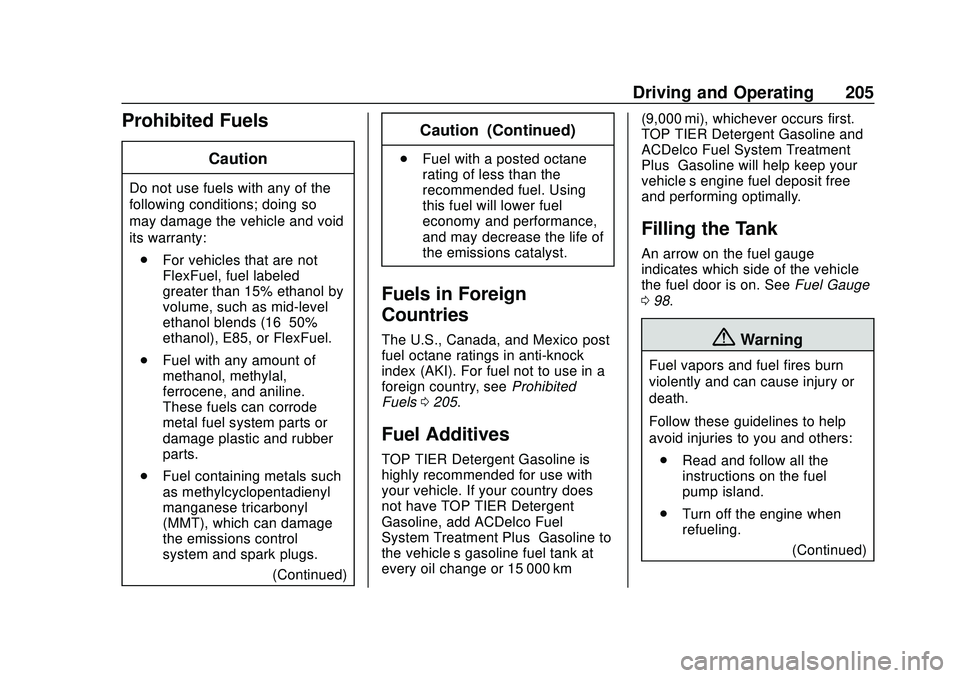
Chevrolet Corvette Owner Manual (GMNA-Localizing-U.S./Canada/Mexico-
12470550) - 2020 - CRC - 4/23/20
Driving and Operating 205
Prohibited Fuels
Caution
Do not use fuels with any of the
following conditions; doing so
may damage the vehicle and void
its warranty:. For vehicles that are not
FlexFuel, fuel labeled
greater than 15% ethanol by
volume, such as mid-level
ethanol blends (16–50%
ethanol), E85, or FlexFuel.
. Fuel with any amount of
methanol, methylal,
ferrocene, and aniline.
These fuels can corrode
metal fuel system parts or
damage plastic and rubber
parts.
. Fuel containing metals such
as methylcyclopentadienyl
manganese tricarbonyl
(MMT), which can damage
the emissions control
system and spark plugs.
(Continued)
Caution (Continued)
.Fuel with a posted octane
rating of less than the
recommended fuel. Using
this fuel will lower fuel
economy and performance,
and may decrease the life of
the emissions catalyst.
Fuels in Foreign
Countries
The U.S., Canada, and Mexico post
fuel octane ratings in anti-knock
index (AKI). For fuel not to use in a
foreign country, see Prohibited
Fuels 0205.
Fuel Additives
TOP TIER Detergent Gasoline is
highly recommended for use with
your vehicle. If your country does
not have TOP TIER Detergent
Gasoline, add ACDelco Fuel
System Treatment Plus−Gasoline to
the vehicle’ s gasoline fuel tank at
every oil change or 15 000 km (9,000 mi), whichever occurs first.
TOP TIER Detergent Gasoline and
ACDelco Fuel System Treatment
Plus−Gasoline will help keep your
vehicle’s engine fuel deposit free
and performing optimally.
Filling the Tank
An arrow on the fuel gauge
indicates which side of the vehicle
the fuel door is on. See
Fuel Gauge
0 98.
{Warning
Fuel vapors and fuel fires burn
violently and can cause injury or
death.
Follow these guidelines to help
avoid injuries to you and others:
. Read and follow all the
instructions on the fuel
pump island.
. Turn off the engine when
refueling.
(Continued)
Page 219 of 336
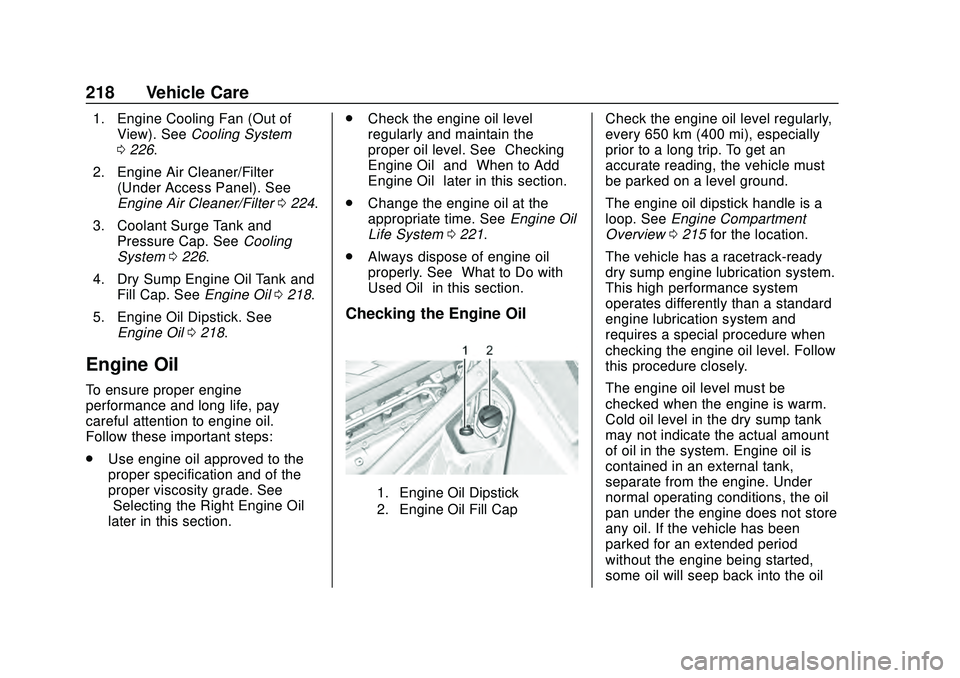
Chevrolet Corvette Owner Manual (GMNA-Localizing-U.S./Canada/Mexico-
12470550) - 2020 - CRC - 4/23/20
218 Vehicle Care
1. Engine Cooling Fan (Out ofView). See Cooling System
0 226.
2. Engine Air Cleaner/Filter (Under Access Panel). See
Engine Air Cleaner/Filter 0224.
3. Coolant Surge Tank and Pressure Cap. See Cooling
System 0226.
4. Dry Sump Engine Oil Tank and Fill Cap. See Engine Oil0218.
5. Engine Oil Dipstick. See Engine Oil 0218.
Engine Oil
To ensure proper engine
performance and long life, pay
careful attention to engine oil.
Follow these important steps:
.
Use engine oil approved to the
proper specification and of the
proper viscosity grade. See
“Selecting the Right Engine Oil”
later in this section. .
Check the engine oil level
regularly and maintain the
proper oil level. See “Checking
Engine Oil” and“When to Add
Engine Oil” later in this section.
. Change the engine oil at the
appropriate time. See Engine Oil
Life System 0221.
. Always dispose of engine oil
properly. See “What to Do with
Used Oil” in this section.
Checking the Engine Oil
1. Engine Oil Dipstick
2. Engine Oil Fill Cap
Check the engine oil level regularly,
every 650 km (400 mi), especially
prior to a long trip. To get an
accurate reading, the vehicle must
be parked on a level ground.
The engine oil dipstick handle is a
loop. See Engine Compartment
Overview 0215 for the location.
The vehicle has a racetrack-ready
dry sump engine lubrication system.
This high performance system
operates differently than a standard
engine lubrication system and
requires a special procedure when
checking the engine oil level. Follow
this procedure closely.
The engine oil level must be
checked when the engine is warm.
Cold oil level in the dry sump tank
may not indicate the actual amount
of oil in the system. Engine oil is
contained in an external tank,
separate from the engine. Under
normal operating conditions, the oil
pan under the engine does not store
any oil. If the vehicle has been
parked for an extended period
without the engine being started,
some oil will seep back into the oil
Page 220 of 336
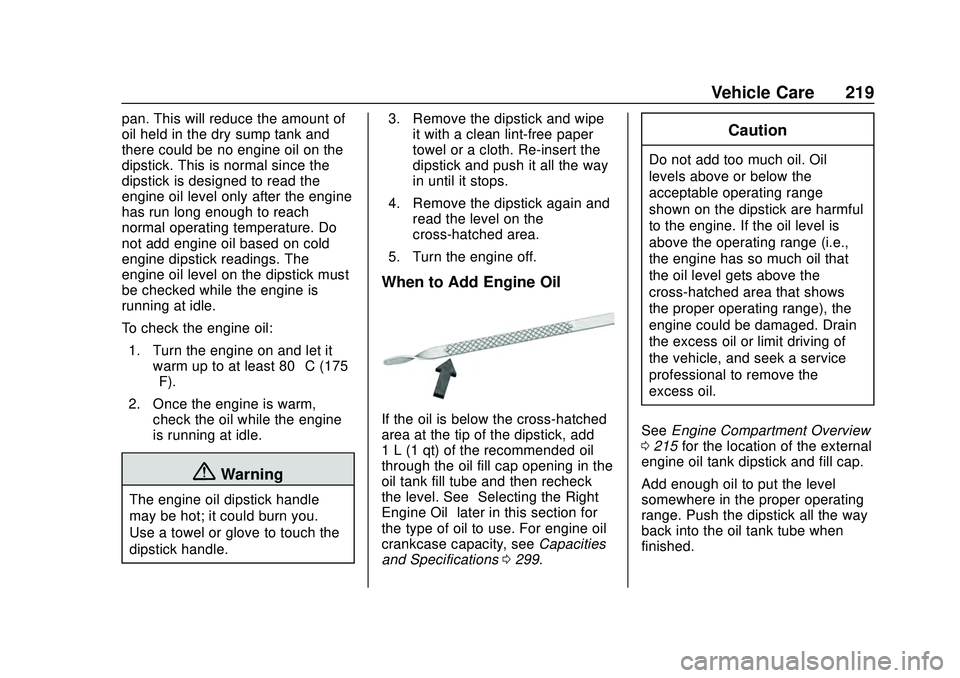
Chevrolet Corvette Owner Manual (GMNA-Localizing-U.S./Canada/Mexico-
12470550) - 2020 - CRC - 4/23/20
Vehicle Care 219
pan. This will reduce the amount of
oil held in the dry sump tank and
there could be no engine oil on the
dipstick. This is normal since the
dipstick is designed to read the
engine oil level only after the engine
has run long enough to reach
normal operating temperature. Do
not add engine oil based on cold
engine dipstick readings. The
engine oil level on the dipstick must
be checked while the engine is
running at idle.
To check the engine oil:1. Turn the engine on and let it warm up to at least 80 °C (175
°F).
2. Once the engine is warm, check the oil while the engine
is running at idle.
{Warning
The engine oil dipstick handle
may be hot; it could burn you.
Use a towel or glove to touch the
dipstick handle. 3. Remove the dipstick and wipe
it with a clean lint-free paper
towel or a cloth. Re-insert the
dipstick and push it all the way
in until it stops.
4. Remove the dipstick again and read the level on the
cross-hatched area.
5. Turn the engine off.
When to Add Engine Oil
If the oil is below the cross-hatched
area at the tip of the dipstick, add
1 L (1 qt) of the recommended oil
through the oil fill cap opening in the
oil tank fill tube and then recheck
the level. See “Selecting the Right
Engine Oil” later in this section for
the type of oil to use. For engine oil
crankcase capacity, see Capacities
and Specifications 0299.
Caution
Do not add too much oil. Oil
levels above or below the
acceptable operating range
shown on the dipstick are harmful
to the engine. If the oil level is
above the operating range (i.e.,
the engine has so much oil that
the oil level gets above the
cross-hatched area that shows
the proper operating range), the
engine could be damaged. Drain
the excess oil or limit driving of
the vehicle, and seek a service
professional to remove the
excess oil.
See Engine Compartment Overview
0 215 for the location of the external
engine oil tank dipstick and fill cap.
Add enough oil to put the level
somewhere in the proper operating
range. Push the dipstick all the way
back into the oil tank tube when
finished.
Page 221 of 336
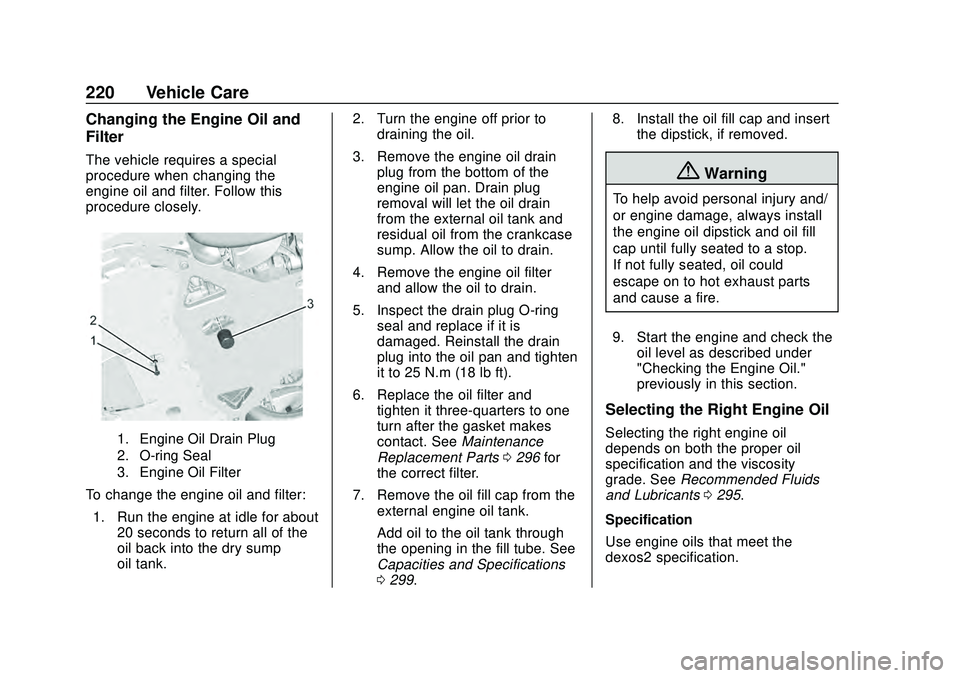
Chevrolet Corvette Owner Manual (GMNA-Localizing-U.S./Canada/Mexico-
12470550) - 2020 - CRC - 4/23/20
220 Vehicle Care
Changing the Engine Oil and
Filter
The vehicle requires a special
procedure when changing the
engine oil and filter. Follow this
procedure closely.
1. Engine Oil Drain Plug
2. O-ring Seal
3. Engine Oil Filter
To change the engine oil and filter:1. Run the engine at idle for about 20 seconds to return all of the
oil back into the dry sump
oil tank. 2. Turn the engine off prior to
draining the oil.
3. Remove the engine oil drain plug from the bottom of the
engine oil pan. Drain plug
removal will let the oil drain
from the external oil tank and
residual oil from the crankcase
sump. Allow the oil to drain.
4. Remove the engine oil filter and allow the oil to drain.
5. Inspect the drain plug O-ring seal and replace if it is
damaged. Reinstall the drain
plug into the oil pan and tighten
it to 25 N.m (18 lb ft).
6. Replace the oil filter and tighten it three-quarters to one
turn after the gasket makes
contact. See Maintenance
Replacement Parts 0296 for
the correct filter.
7. Remove the oil fill cap from the external engine oil tank.
Add oil to the oil tank through
the opening in the fill tube. See
Capacities and Specifications
0299. 8. Install the oil fill cap and insert
the dipstick, if removed.
{Warning
To help avoid personal injury and/
or engine damage, always install
the engine oil dipstick and oil fill
cap until fully seated to a stop.
If not fully seated, oil could
escape on to hot exhaust parts
and cause a fire.
9. Start the engine and check the oil level as described under
"Checking the Engine Oil."
previously in this section.
Selecting the Right Engine Oil
Selecting the right engine oil
depends on both the proper oil
specification and the viscosity
grade. See Recommended Fluids
and Lubricants 0295.
Specification
Use engine oils that meet the
dexos2 specification.
Page 223 of 336
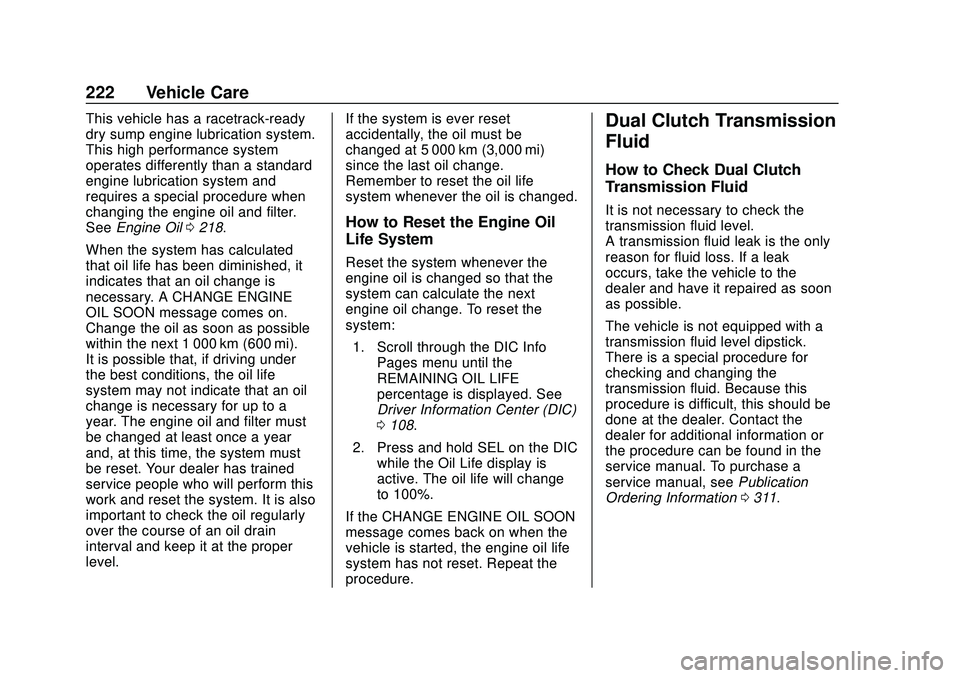
Chevrolet Corvette Owner Manual (GMNA-Localizing-U.S./Canada/Mexico-
12470550) - 2020 - CRC - 4/23/20
222 Vehicle Care
This vehicle has a racetrack-ready
dry sump engine lubrication system.
This high performance system
operates differently than a standard
engine lubrication system and
requires a special procedure when
changing the engine oil and filter.
SeeEngine Oil 0218.
When the system has calculated
that oil life has been diminished, it
indicates that an oil change is
necessary. A CHANGE ENGINE
OIL SOON message comes on.
Change the oil as soon as possible
within the next 1 000 km (600 mi).
It is possible that, if driving under
the best conditions, the oil life
system may not indicate that an oil
change is necessary for up to a
year. The engine oil and filter must
be changed at least once a year
and, at this time, the system must
be reset. Your dealer has trained
service people who will perform this
work and reset the system. It is also
important to check the oil regularly
over the course of an oil drain
interval and keep it at the proper
level. If the system is ever reset
accidentally, the oil must be
changed at 5 000 km (3,000 mi)
since the last oil change.
Remember to reset the oil life
system whenever the oil is changed.
How to Reset the Engine Oil
Life System
Reset the system whenever the
engine oil is changed so that the
system can calculate the next
engine oil change. To reset the
system:
1. Scroll through the DIC Info Pages menu until the
REMAINING OIL LIFE
percentage is displayed. See
Driver Information Center (DIC)
0108.
2. Press and hold SEL on the DIC while the Oil Life display is
active. The oil life will change
to 100%.
If the CHANGE ENGINE OIL SOON
message comes back on when the
vehicle is started, the engine oil life
system has not reset. Repeat the
procedure.
Dual Clutch Transmission
Fluid
How to Check Dual Clutch
Transmission Fluid
It is not necessary to check the
transmission fluid level.
A transmission fluid leak is the only
reason for fluid loss. If a leak
occurs, take the vehicle to the
dealer and have it repaired as soon
as possible.
The vehicle is not equipped with a
transmission fluid level dipstick.
There is a special procedure for
checking and changing the
transmission fluid. Because this
procedure is difficult, this should be
done at the dealer. Contact the
dealer for additional information or
the procedure can be found in the
service manual. To purchase a
service manual, see Publication
Ordering Information 0311.
Page 229 of 336
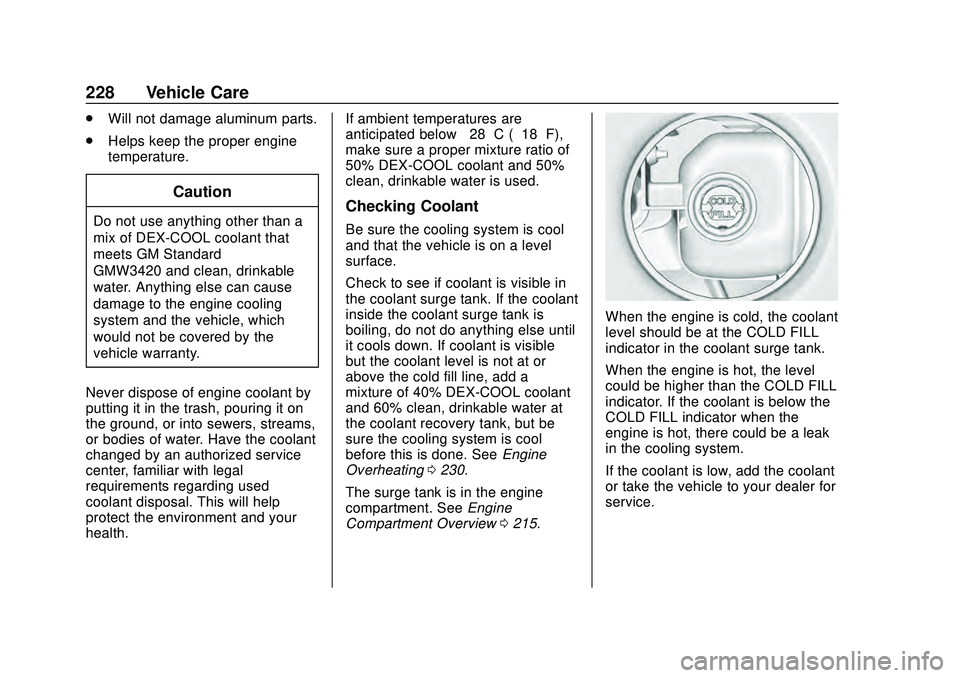
Chevrolet Corvette Owner Manual (GMNA-Localizing-U.S./Canada/Mexico-
12470550) - 2020 - CRC - 4/23/20
228 Vehicle Care
.Will not damage aluminum parts.
. Helps keep the proper engine
temperature.
Caution
Do not use anything other than a
mix of DEX-COOL coolant that
meets GM Standard
GMW3420 and clean, drinkable
water. Anything else can cause
damage to the engine cooling
system and the vehicle, which
would not be covered by the
vehicle warranty.
Never dispose of engine coolant by
putting it in the trash, pouring it on
the ground, or into sewers, streams,
or bodies of water. Have the coolant
changed by an authorized service
center, familiar with legal
requirements regarding used
coolant disposal. This will help
protect the environment and your
health. If ambient temperatures are
anticipated below
−28 °C (−18 °F),
make sure a proper mixture ratio of
50% DEX-COOL coolant and 50%
clean, drinkable water is used.Checking Coolant
Be sure the cooling system is cool
and that the vehicle is on a level
surface.
Check to see if coolant is visible in
the coolant surge tank. If the coolant
inside the coolant surge tank is
boiling, do not do anything else until
it cools down. If coolant is visible
but the coolant level is not at or
above the cold fill line, add a
mixture of 40% DEX-COOL coolant
and 60% clean, drinkable water at
the coolant recovery tank, but be
sure the cooling system is cool
before this is done. See Engine
Overheating 0230.
The surge tank is in the engine
compartment. See Engine
Compartment Overview 0215.
When the engine is cold, the coolant
level should be at the COLD FILL
indicator in the coolant surge tank.
When the engine is hot, the level
could be higher than the COLD FILL
indicator. If the coolant is below the
COLD FILL indicator when the
engine is hot, there could be a leak
in the cooling system.
If the coolant is low, add the coolant
or take the vehicle to your dealer for
service.
Page 245 of 336
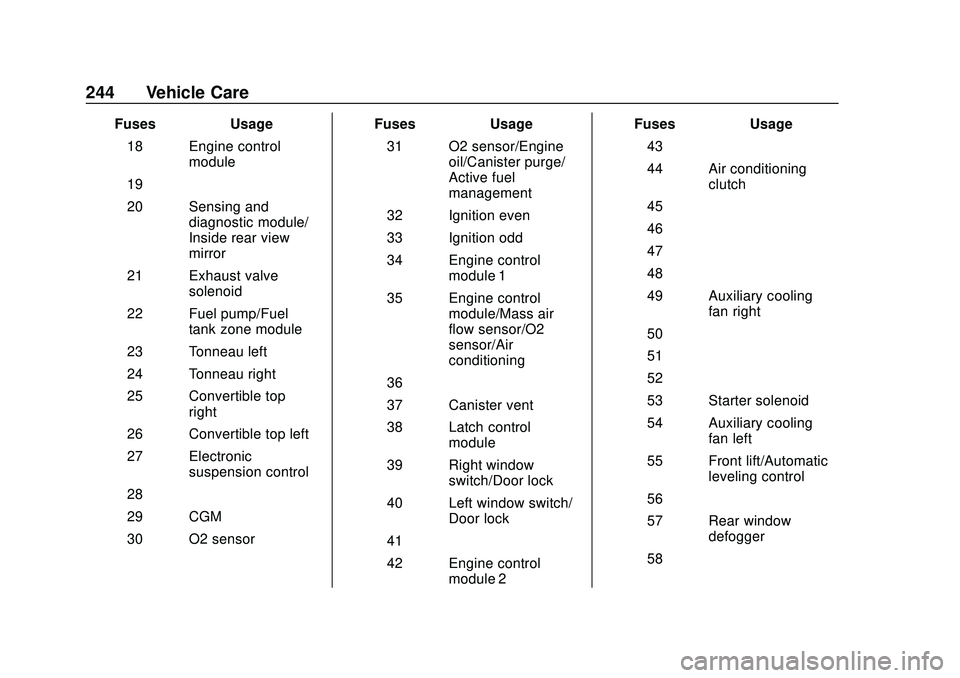
Chevrolet Corvette Owner Manual (GMNA-Localizing-U.S./Canada/Mexico-
12470550) - 2020 - CRC - 4/23/20
244 Vehicle Care
FusesUsage
18 Engine control module
19 –
20 Sensing and diagnostic module/
Inside rear view
mirror
21 Exhaust valve solenoid
22 Fuel pump/Fuel tank zone module
23 Tonneau left
24 Tonneau right
25 Convertible top right
26 Convertible top left
27 Electronic suspension control
28 –
29 CGM
30 O2 sensor Fuses
Usage
31 O2 sensor/Engine oil/Canister purge/
Active fuel
management
32 Ignition even
33 Ignition odd
34 Engine control module 1
35 Engine control module/Mass air
flow sensor/O2
sensor/Air
conditioning
36 –
37 Canister vent
38 Latch control module
39 Right window switch/Door lock
40 Left window switch/ Door lock
41 –
42 Engine control module 2 Fuses
Usage
43 –
44 Air conditioning clutch
45 –
46 –
47 –
48 –
49 Auxiliary cooling fan right
50 –
51 –
52 –
53 Starter solenoid
54 Auxiliary cooling fan left
55 Front lift/Automatic leveling control
56 –
57 Rear window defogger
58 –